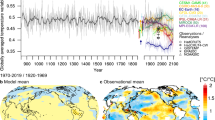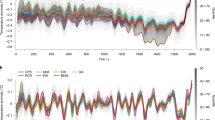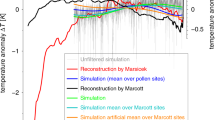Abstract
Evidence from Greenland ice cores shows that year-to-year temperature variability was probably higher in some past cold periods1, but there is considerable interest in determining whether global warming is increasing climate variability at present2,3,4,5,6. This interest is motivated by an understanding that increased variability and resulting extreme weather conditions may be more difficult for society to adapt to than altered mean conditions3. So far, however, in spite of suggestions of increased variability2, there is considerable uncertainty as to whether it is occurring7. Here we show that although fluctuations in annual temperature have indeed shown substantial geographical variation over the past few decades2, the time-evolving standard deviation of globally averaged temperature anomalies has been stable. A feature of the changes has been a tendency for many regions of low variability to experience increases, which might contribute to the perception of increased climate volatility. The normalization of temperature anomalies2 creates the impression of larger relative overall increases, but our use of absolute values, which we argue is a more appropriate approach, reveals little change. Regionally, greater year-to-year changes recently occurred in much of North America and Europe. Many climate models predict that total variability will ultimately decrease under high greenhouse gas concentrations, possibly associated with reductions in sea-ice cover. Our findings contradict the view that a warming world will automatically be one of more overall climatic variation.
This is a preview of subscription content, access via your institution
Access options
Subscribe to this journal
Receive 51 print issues and online access
$199.00 per year
only $3.90 per issue
Buy this article
- Purchase on Springer Link
- Instant access to full article PDF
Prices may be subject to local taxes which are calculated during checkout




Similar content being viewed by others
References
Steffensen, J. P. et al. High-resolution Greenland Ice Core data show abrupt climate change happens in few years. Science 321, 680–684 (2008)
Hansen, J., Sato, M. & Ruedy, R. Perception of climate change. Proc. Natl Acad. Sci. USA 109, E2415–E2423 (2012)
Rahmstorf, S. & Coumou, D. Increase of extreme events in a warming world. Proc. Natl Acad. Sci. USA 108, 17905–17909 (2011)
Stott, P. A., Stone, D. A. & Allen, M. R. Human contribution to the European heatwave of 2003. Nature 432, 610–614 (2004)
Field C. B., et al., eds. (eds) Managing the Risks of Extreme Events and Disasters to Advance Climate Change Adaptation (Cambridge Univ. Press, 2012)
Coumou, D. & Rahmstorf, S. A decade of weather extremes. Nature Clim. Change 2, 491–496 (2012)
Rhines, A. & Huybers, P. Frequent summer temperature extremes reflect changes in the mean, not the variance. Proc. Natl Acad. Sci. USA 110, E546 (2013)
Hansen, J., Ruedy, R., Sato, M. & Lo, K. Global surface temperature change. Rev. Geophys. 48, RG4004 (2010)
Trenberth, K. E. Recent observed interdecadal climate changes in the northern-hemisphere. Bull. Am. Meteorol. Soc. 71, 988–993 (1990)
Hartmann, B. & Wendler, G. The significance of the 1976 Pacific climate shift in the climatology of Alaska. J. Clim. 18, 4824–4839 (2005)
Uppala, S. M. et al. The ERA-40 re-analysis. Q. J. R. Meteorol. Soc. 131, 2961–3012 (2005)
Dee, D. P. et al. The ERA-Interim reanalysis: configuration and performance of the data assimilation system. Q. J. R. Meteorol. Soc. 137, 553–597 (2011)
Schär, C. et al. The role of increasing temperature variability in European summer heatwaves. Nature 427, 332–336 (2004)
Seidel, D. J., Fu, Q., Randel, W. J. & Reichler, T. J. Widening of the tropical belt in a changing climate. Nature Geosci. 1, 21–24 (2008)
Bender, F. A. M., Ramanathan, V. & Tselioudis, G. Changes in extratropical storm track cloudiness 1983–2008: observational support for a poleward shift. Clim. Dyn. 38, 2037–2053 (2012)
Zhou, Y. P., Xu, K. M., Sud, Y. C. & Betts, A. K. Recent trends of the tropical hydrological cycle inferred from Global Precipitation Climatology Project and International Satellite Cloud Climatology Project data. J. Geophys. Res. 116, D09101 (2011)
Johanson, C. M. & Fu, Q. Hadley cell widening: model simulations versus observations. J. Clim. 22, 2713–2725 (2009)
Lu, J., Deser, C. & Reichler, T. Cause of the widening of the tropical belt since 1958. Geophys. Res. Lett. 36, L03803 (2009)
Jones, P. D. et al. Hemispheric and large-scale land-surface air temperature variations: an extensive revision and an update to 2010. J. Geophys. Res. 117, D05127 (2012)
Jones, C. D. et al. The HadGEM2-ES implementation of CMIP5 centennial simulations. Geosci. Model Dev. 4, 543–570 (2011)
Taylor, K. E., Stouffer, R. J. & Meehl, G. A. A. N. Overview of CMIP5 and the experiment design. Bull. Am. Meteorol. Soc. 93, 485–498 (2012)
Moss, R. H. et al. The next generation of scenarios for climate change research and assessment. Nature 463, 747–756 (2010)
Budikova, D. Role of Arctic sea ice in global atmospheric circulation: a review. Global Planet. Change 68, 149–163 (2009)
Dethloff, K. et al. A dynamical link between the Arctic and the global climate system. Geophys. Res. Lett. 33, L03703 (2006)
Francis, J. A. & Vavrus, S. J. Evidence linking Arctic amplification to extreme weather in mid-latitudes. Geophys. Res. Lett. 39, L06801 (2012)
Screen, J. A. & Simmonds, I. The central role of diminishing sea ice in recent Arctic temperature amplification. Nature 464, 1334–1337 (2010)
Räisänen, J. CO2-induced changes in interannual temperature and precipitation variability in 19 CMIP2 experiments. J. Clim. 15, 2395–2411 (2002)
Kharin, V. V., Zwiers, F. W., Zhang, X. & Hegerl, G. C. Changes in temperature and precipitation extremes in the IPCC ensemble of global coupled model simulations. J. Clim. 20, 1419–1444 (2007)
Katz, R. W. & Brown, B. G. Extreme events in a changing climate: variability is more important than averages. Clim. Change 21, 289–302 (1992)
Simmons, A. J. et al. Comparison of trends and low-frequency variability in CRU, ERA-40, and NCEP/NCAR analyses of surface air temperature. J. Geophys. Res. 109, D24115 (2004)
Simmons, A. J., Willett, K. M., Jones, P. D., Thorne, P. W. & Dee, D. P. Low-frequency variations in surface atmospheric humidity, temperature, and precipitation: Inferences from reanalyses and monthly gridded observational data sets. J. Geophys. Res. 115, D01110 (2010)
Acknowledgements
We gratefully acknowledge the Newton Institute for Mathematical Sciences programme Mathematical and Statistical Approaches to Climate Modelling and Prediction. C.H. also acknowledges the CEH National Capability Budget. P.D.J. has been supported by the US DOE (grant DE-SC0005689). V.N.L. and T.M.L. were supported by NERC (grant NE/F005474/1).
Author information
Authors and Affiliations
Contributions
C.H. devised the paper and figure structure, performed the numerical analyses and led the interpretation of the results. P.D.J. provided the individual CRU station data. V.N.L. assisted in processing the ECMWF re-analysis products. P.M.C. aided with selection of main results for presentation. T.M.L. and P.M.C. helped to place results in the context of the broader climate change debate. All authors contributed to writing the paper.
Corresponding author
Ethics declarations
Competing interests
The authors declare no competing financial interests.
Supplementary information
Supplementary Information
This file contains Supplementary Text, Supplementary Tables 1-2 and Supplementary Figures 1-8. It focuses on (a) reproducing the main paper figures, but given as individual seasons, (b) showing examples of weather station temperature data and (c) presenting predictions by the individual models that contributed to the CMIP5 database. (PDF 954 kb)
Rights and permissions
About this article
Cite this article
Huntingford, C., Jones, P., Livina, V. et al. No increase in global temperature variability despite changing regional patterns. Nature 500, 327–330 (2013). https://doi.org/10.1038/nature12310
Received:
Accepted:
Published:
Issue Date:
DOI: https://doi.org/10.1038/nature12310
This article is cited by
-
Projected changes in the interannual variability of surface air temperature using CMIP6 simulations
Climate Dynamics (2024)
-
Temperature fluctuation promotes the thermal adaptation of soil microbial respiration
Nature Ecology & Evolution (2023)
-
Change of probability density distributions of summer temperatures in different climate zones
Frontiers of Earth Science (2023)
-
Contrast responses of strong and weak winter extreme cold events in the Northern Hemisphere to global warming
Climate Dynamics (2023)
-
Spatiotemporal dynamics of annual, seasonal, and extreme temperature over upper Indus basin
Theoretical and Applied Climatology (2023)
Comments
By submitting a comment you agree to abide by our Terms and Community Guidelines. If you find something abusive or that does not comply with our terms or guidelines please flag it as inappropriate.



